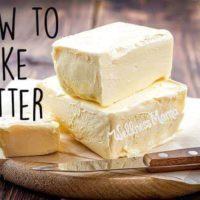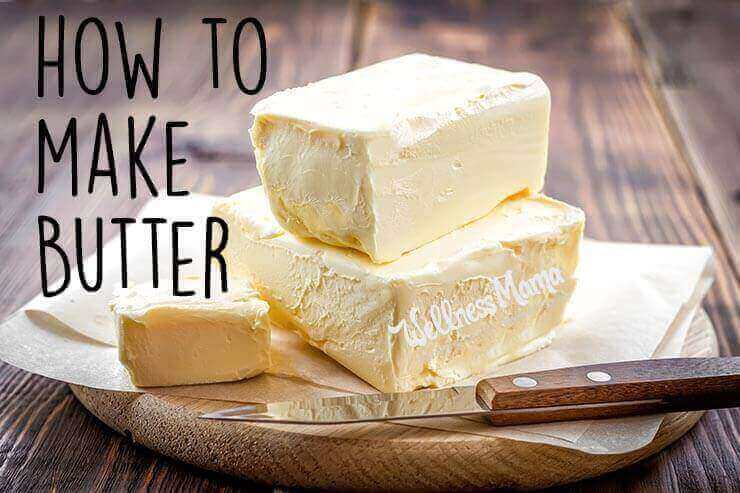As a child, I didn’t have much of an awareness of where my food came from beyond the grocery store. I was an adult the first time I made butter and I was so amazed that you could do it yourself. There is a certain satisfaction that comes with making something yourself that you previously purchased from the store with little thought as to where it came from.
How Butter Is Made
Butter is made from the cream that rises to the top of whole milk when it is cooled. This cream has a milk fat content of at least 30%. By agitating the cream, the membranes surrounding the fat molecules are broken, allowing the molecules to stick together. If you agitate the cream for a short amount of time you will make whipped cream. If you persist, the whipped cream is eventually broken down and you will achieve butter.
I personally find it quite fascinating that you can take a liquid and turn it into a solid by simply agitating it. If you are a science geek like me, you can read more in depth about what happens to milk when making butter here.
Choosing Your Cream
In order to take full advantage of all of the health benefits of butter, it is best to use raw cream from grass-fed cows. If you do not have access to grass-fed raw milk, you can also make butter from organic whipping cream that you can buy at the store.
If using raw milk, refrigerate overnight or until the cream has collected at the top of the jar. Skim the cream by gently dipping a small ladle down into the cream until if fills the ladle by flowing up over the sides. It is best not to scoop as this can cause the cream to mix back into the milk. Continue to do this until all the cream is collected. If you begin to see the thinner milk sneaking into your ladle then you probably have as much cream as you will be able to get.
The milk leftover once you’ve removed the cream from the top is still totally drinkable. It’s now “reduced fat” milk.
See below for variations on flavoring butter.
Getting Ready:
- I use a stand mixer with a whisk attachment for making butter.
- Measure your cream. 2 cups of cream yields approximately ½ cup (1 stick) of butter.
- You will need a fine strainer, a bowl, a wide spoon, and clean, cold water.

Homemade Butter Recipe
Servings
Ingredients
- 2 cups heavy cream preferably from raw milk or store-bought organic
Instructions
- Put the cream into your mixing bowl. It is important to only fill the bowl halfway so it does not overflow as air is whipped into the cream. (Take my word for it!)
- Turn mixer on low to medium-low at first to prevent splashing. Once the cream begins to thicken you can turn it up to medium.
- Mix for about 15 minutes. This time can vary depending on how much cream you are using and what type if mixer you have.
- As it thickens it will first change to whipped cream. After the whipped cream stage it will begin to deflate and break down. When this begins to happen, stay close. When it makes the change to butter it can happen very quickly. It will also start to splash again so you can hang a towel over the mixer if you’d like.
- When you see the butter begin to clump and stick to your whisk, it is done mixing.
- Put your strainer over a bowl and pour the contents of your mixing bowl into the strainer. The solids that collect in the strainer are the butter and the liquid that collects in the bowl is buttermilk.
- Now you need to “rinse” the butter. It is important to remove as much buttermilk as possible to keep the butter from going rancid. Put the butter back in your mixing bowl and cover with clean, cold water.
- With the back of your wide spoon, begin pressing the butter into the side of the bowl. The water will get cloudy as the buttermilk is “cleaned” out of the butter. Pour the water off and add more cold water.
- Repeat this process 4-5 times or until the water stays clear.
- Done! Store in refrigerator or at room temperature if you will use it within a week or two.
Nutrition
Notes
Butter Variations
For salted butter, simply add a healthy pinch of salt per ½ cup of butter. Work it in with the back of your wide spoon.
For spreadable butter, whip ½ cup butter in your mixer with 1 teaspoon high quality olive oil.
For honey butter, whip ½ cup butter with ¼ cup raw honey until smooth.
Learn how to make herb infused compound butter here.
Learn how to make ghee here.
Make ice cream!
Fun For Children
The whole butter making process can be a great science lesson for kids. You can get them more involved by showing them how to make butter in a mason jar. Fill a pint mason jar halfway with cream, seal it tightly with a lid, and let them shake it. They will have to shake for quite a while, but my kids think it is so cool that they don’t mind at all. Eventually, you will see the same transformation you saw in your mixer take place in the jar. When the clump of butter comes together, simply follow the same steps for rinsing it and voila, you have butter!
Have you ever made butter? Will you try any of the variations?


Leave a Reply